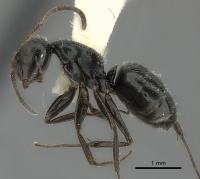Camponotus canescens
| Camponotus canescens | |
|---|---|

| |
| Scientific classification | |
| Kingdom: | Animalia |
| Phylum: | Arthropoda |
| Class: | Insecta |
| Order: | Hymenoptera |
| Family: | Formicidae |
| Subfamily: | Formicinae |
| Tribe: | Camponotini |
| Genus: | Camponotus |
| Species: | C. canescens |
| Binomial name | |
| Camponotus canescens Mayr, 1870 | |
| Subspecies | |
| |
Identification
Distribution
Latitudinal Distribution Pattern
Latitudinal Range: 15.25° to -22.908°.
| North Temperate |
North Subtropical |
Tropical | South Subtropical |
South Temperate |
- Source: AntMaps
Distribution based on Regional Taxon Lists
Neotropical Region: Bolivia, Brazil, Colombia (type locality), Costa Rica, Panama, Trinidad and Tobago.
Distribution based on AntMaps
Distribution based on AntWeb specimens
Check data from AntWeb
Countries Occupied
| Number of countries occupied by this species based on AntWiki Regional Taxon Lists. In general, fewer countries occupied indicates a narrower range, while more countries indicates a more widespread species. |

|
Estimated Abundance
| Relative abundance based on number of AntMaps records per species (this species within the purple bar). Fewer records (to the left) indicates a less abundant/encountered species while more records (to the right) indicates more abundant/encountered species. |

|
Biology
Castes
Nomenclature
The following information is derived from Barry Bolton's Online Catalogue of the Ants of the World.
- canescens. Camponotus canescens Mayr, 1870a: 386 (w.) COLOMBIA.
- Type-material: syntype workers (number not stated).
- Type-locality: Colombia (“New Granada”): (no further data) (Lindig).
- Type-depository: NHMW.
- [Misspelled as conescens by Luederwaldt, 1918: 51.]
- Menozzi, 1935b: 203 (q.); Wheeler, G.C. & Wheeler, J. 1953e: 194 (l.).
- Combination in C. (Myrmobrachys): Forel, 1914a: 270.
- Status as species: Dalla Torre, 1893: 223; Emery, 1896d: 377 (in list); Forel, 1899c: 140; Forel, 1907e: 10; Forel, 1908b: 71; Forel, 1908c: 412; Forel, 1912i: 78; Luederwaldt, 1918: 51; Wheeler, W.M. 1922c: 16; Emery, 1925b: 163; Borgmeier, 1927c: 156; Menozzi, 1927c: 268; Menozzi, 1935b: 202; Eidmann, 1936b: 97; Wheeler, W.M. 1942: 258; Kempf, 1972a: 51; Bolton, 1995b: 90; Branstetter & Sáenz, 2012: 255; Bezděčková, et al. 2015: 112; Mackay & Mackay, 2019: 755.
- Distribution: Bolivia, Brazil, Colombia, Costa Rica, Guatemala, Panama, Peru, Trinidad.
- Current subspecies: nominal plus antennatus, stomatus.
Description
References
- Bolton, B. 1995b. A new general catalogue of the ants of the world. Cambridge, Mass.: Harvard University Press, 504 pp. (page 90, catalogue)
- Forel, A. 1914a. Le genre Camponotus Mayr et les genres voisins. Rev. Suisse Zool. 22: 257-276 (page 270, combination in C. (Myrmobrachys))
- Mayr, G. 1870a. Formicidae novogranadenses. Sitzungsber. Kais. Akad. Wiss. Wien Math.-Naturwiss. Cl. Abt. I 61: 370-417 (page 386, worker described)
- Menozzi, C. 1935b. Spedizione del Prof. Nello Beccari nella Guiana Britannica. Hymenoptera-Formicidae. Redia 21: 189-203 (page 203, queen described)
- Wheeler, G. C.; Wheeler, J. 1953e. The ant larvae of the subfamily Formicinae. Part II. Ann. Entomol. Soc. Am. 46: 175-217 (page 194, larva described)
References based on Global Ant Biodiversity Informatics
- Adams B. J., S. A. Schnitzer, and S. P. Yanoviak. 2019. Connectivity explains local ant community structure in a Neotropical forest canopy: a large-scale experimental approach. Ecology 100(6): e02673.
- Araujo Castilho G., F. Barbosa Noll, E. R. da Silva, and E. F. dos Santos. 2011. Diversidade de Formicidae (Hymenoptera) em um fragmento de Floresta Estacional Semidecídua no Noroeste do estado de São Paulo, Brasil. R. bras. Bioci., Porto Alegre 9(2): 224-230.
- Bezdeckova K., P. Bedecka, and I. Machar. 2015. A checklist of the ants (Hymenoptera: Formicidae) of Peru. Zootaxa 4020 (1): 101–133.
- Dattilo W. et al. 2019. MEXICO ANTS: incidence and abundance along the Nearctic-Neotropical interface. Ecology https://doi.org/10.1002/ecy.2944
- Emery C. 1896. Studi sulle formiche della fauna neotropica. XVII-XXV. Bullettino della Società Entomologica Italiana 28: 33-107.
- Fernández, F. and S. Sendoya. 2004. Lista de las hormigas neotropicales. Biota Colombiana Volume 5, Number 1.
- Forel A. 1907. Formiciden aus dem Naturhistorischen Museum in Hamburg. II. Teil. Neueingänge seit 1900. Mitt. Naturhist. Mus. Hambg. 24: 1-20.
- Forel A. 1908. Ameisen aus Sao Paulo (Brasilien), Paraguay etc. gesammelt von Prof. Herm. v. Ihering, Dr. Lutz, Dr. Fiebrig, etc. Verhandlungen der Kaiserlich-Königlichen Zoologisch-Botanischen Gesellschaft in Wien 58: 340-418.
- Forel A. 1908. Fourmis de Costa-Rica récoltées par M. Paul Biolley. Bulletin de la Société Vaudoise des Sciences Naturelles 44: 35-72.
- Forel A. 1912. Formicides néotropiques. Part VI. 5me sous-famille Camponotinae Forel. Mémoires de la Société Entomologique de Belgique. 20: 59-92.
- Kempf, W.W. 1972. Catalago abreviado das formigas da regiao Neotropical (Hym. Formicidae) Studia Entomologica 15(1-4).
- Longino J. T., J. Coddington, and R. K. Colwell. 2002. The ant fauna of a tropical rain forest: estimating species richness three different ways. Ecology 83: 689-702.
- Maes, J.-M. and W.P. MacKay. 1993. Catalogo de las hormigas (Hymenoptera: Formicidae) de Nicaragua. Revista Nicaraguense de Entomologia 23.
- Menozzi C. 1927. Formiche raccolte dal Sig. H. Schmidt nei dintorni di San José di Costa Rica. Entomologische Mitteilungen. Berlin-Dahlem. 16: 266-277.
- Menozzi C. 1935. Spedizione del Prof. Nello Beccari nella Guiana Britannica. Hymenoptera-Formicidae. Redia. 21: 189-203.
- Miranda P. N., F. B. Baccaro, E. F. Morato, M. A. Oliveira. J. H. C. Delabie. 2017. Limited effects of low-intensity forest management on ant assemblages in southwestern Amazonian forests. Biodivers. Conserv. DOI 10.1007/s10531-017-1368-y
- Rosa da Silva R. 1999. Formigas (Hymenoptera: Formicidae) do oeste de Santa Catarina: historico das coletas e lista atualizada das especies do Estado de Santa Catarina. Biotemas 12(2): 75-100.
- Wheeler W. M. 1922. The ants of Trinidad. American Museum Novitates 45: 1-16.
- Wheeler W. M. 1942. Studies of Neotropical ant-plants and their ants. Bulletin of the Museum of Comparative Zoology 90: 1-262.
- Wilson E. O. 1962. Behavior of Daceton armigerum (Latreille), with a classification of self-grooming movements in ants. Bulletin of the Museum of Comparative Zoology 127: 403-421.

